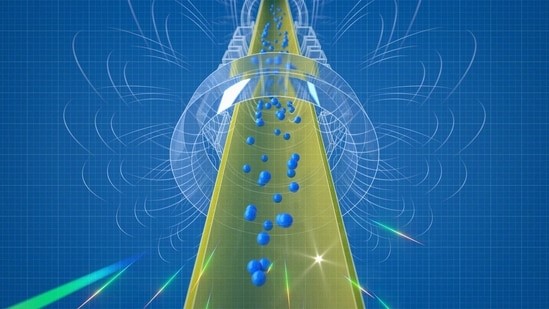For This Reason, Proved! Nothing’s The Issue with Antimatter as It Loses a Little Bit Extra Pizazz Reacts Exact Same Less Than Gravity
Indeed, the recent observation of antimatter particles falling downward due to gravity is a significant milestone in the world of physics. This experiment, conducted at CERN, marks a groundbreaking achievement, even though many physicists had anticipated this outcome, in line with Einstein's theory of relativity dating back to 1915.

Figure 1. Antimatter as It Loses a Little Bit Extra Pizazz Reacts Exact Same Less Than Gravity
Figure 1 shows this observation unequivocally dismisses the notion that gravity could repel antimatter upwards, a finding that, had it been true, would have had profound implications for our fundamental understanding of the universe. Instead, it reaffirms the consistency of antimatter's behaviour with regular matter when it comes to the influence of gravity. The Big Bang, approximately 13.8 billion years ago, is thought to have generated an equal amount of matter, which constitutes everything we can observe, and antimatter, its opposing counterpart.
However, the universe today contains very little antimatter, sparking one of physics' most profound mysteries: What happened to all the antimatter? Jeffrey Hangst, a member of CERN's ALPHA collaboration in Geneva, which conducted the recent experiment, remarked that "Half the universe is missing." He added that in theory, it's possible to construct a universe, identical to ours, using only antimatter, and it would function in precisely the same manner as our universe composed of regular matter. This mystery continues to intrigue physicists and cosmologists as they seek to unravel the fundamental forces at play in the universe's formation and evolution.
Physicists have long speculated that matter and antimatter likely came into contact and annihilated each other almost entirely after the Big Bang. However, in today's universe, matter constitutes approximately 5 percent, while the majority is composed of less understood components like dark matter and dark energy, with antimatter seemingly vanished. One of the intriguing questions about antimatter has revolved around its behaviour under gravity. While the consensus among most physicists was that antimatter would fall in the same manner as regular matter, some had entertained the possibility of a different outcome.
The classic example is the falling apple that inspired Isaac Newton's work on gravity. However, if that apple were made of antimatter, would it have risen into the sky instead of falling to the ground? If antimatter had indeed repelled gravity, it could have implied the possibility of perpetual motion devices and other phenomena that seem impossible with regular matter. Jeffrey Hangst likened the experiment to Galileo's famous, though possibly apocryphal, demonstration in the 16th century, where he purportedly showed that two balls of different masses dropped from the Leaning Tower of Pisa would fall at the same rate. The experiment aimed to answer the question definitively by observing how antimatter behaves under the influence of gravity.
The recent experiment conducted by the ALPHA team at CERN, after 30 years of work on antimatter, was a complex undertaking compared to Galileo's famous experiment. One challenge was the scarcity of antimatter in nature, except for rare, short-lived particles in outer space. However, in 1996, CERN scientists successfully created the first antimatter atoms, antihydrogen.
Another hurdle was the fact that matter and antimatter annihilate each other upon contact due to their opposite electrical charges. To study the effect of gravity on antimatter, the researchers designed a magnetic trap called ALPHA-g, consisting of a 25-centimeter-long bottle with magnets at both ends. They placed approximately 100 extremely cold antihydrogen atoms into this trap. By adjusting the magnet strengths, they allowed the antihydrogen particles, which were moving at about 100 meters per second, to escape from either end of the bottle. They then counted the amount of antimatter annihilated at each end.
The results showed that around 80 percent of the antihydrogen exited from the bottom, similar to the behaviour of bouncing hydrogen atoms in the bottle. This finding confirms that gravity causes antimatter to fall downward, in accordance with Einstein's theory of relativity from 1915. While this experiment rules out the idea that gravity repels antimatter, it does not establish that antimatter behaves exactly like regular matter. Further research will explore this aspect.
Physicist Marco Gersabeck, not involved in the ALPHA research but working at CERN, described the experiment as a significant milestone, marking the beginning of an era of more precise measurements of gravity's impact on antimatter. Efforts to gain a deeper understanding of antimatter involve various approaches, including experiments conducted at CERN's Large Hadron Collider (LHC) to study exotic particles called beauty quarks. Additionally, there is an experiment taking place aboard the International Space Station (ISS) that aims to capture antimatter particles contained within cosmic rays. These diverse experiments contribute to our expanding knowledge of antimatter and its behaviour, shedding light on one of the most intriguing mysteries in physics.
Source:NEWSSOCIAL
Cite this article:
Janani R (2023),For This Reason, Proved! Nothing’s The Issue with Antimatter as It Loses a Little Bit Extra Pizazz Reacts Exact Same Less Than Gravity,Anatechmaz,pp.762

